Coconut Coir in Potting Mix: Sustainable Horticulture
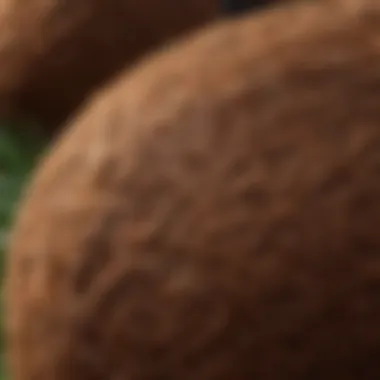
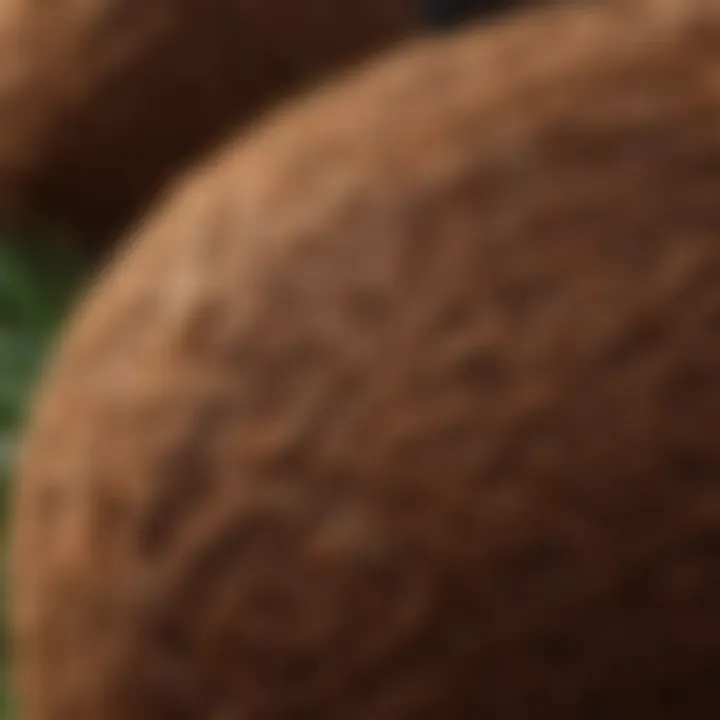
Intro
Coconut coir, a natural fiber extracted from the husk of coconuts, is making waves in horticulture. As more gardeners seek sustainable alternatives to traditional potting mixes, coconut coir stands out for its myriad benefits. Not only does it provide an excellent growing medium, it's also eco-friendly. The use of coconut coir has gained traction in both home gardening and commercial farming.
With an increasing focus on environmental impact, understanding the properties and advantages of coconut coir as a potting mix can significantly enhance gardening practices. It’s not just a trend; it's a movement that aligns with the values of sustainability and efficient resource use.
Topic Overview
Definition and Importance
Coconut coir refers to the fiber from the outer husk of coconuts. It's a versatile material that's used in various forms, from growing mediums to soil enhancement. Its importance in modern horticulture is multifaceted:
- Sustainability: Coir is a renewable resource, offering an alternative to peat moss, which is often harvested unsustainably.
- Water Retention: Coir’s structure allows it to hold water well, making it beneficial for plant health, especially in dry climates.
- Aeration: The fibrous nature of coir promotes healthy root growth by ensuring sufficient aeration.
Brief History and Evolution
Historically, coir has been utilized in various cultures across the globe, primarily as a durable fiber for ropes and mats. Its recent adoption in horticulture stems from a growing awareness of ecological implications associated with popular growing mediums. As gardening practices evolved, so did the use of coconut coir—transforming from textile use to a respected component in potting mixes.
Over time, innovations in processing and preparation of coir have further enhanced its performance as a growing medium. Today, coir is recognized not only for its functional properties but also for its contribution to sustainable horticulture practices.
Key Techniques and Innovations
Sustainable Farming Practices
The integration of coconut coir in potting mixes is a prime example of sustainable farming practices. Using coir helps in:
- Reducing the carbon footprint associated with transporting traditional substrates.
- Encouraging biodiversity by fostering healthier soil environments.
Moreover, the circular economy concept is being adopted with coir, as it repurposes waste from coconut processing. This not only minimizes waste but also extends the lifecycle of resources.
Advanced Agronomic Technologies
As science progresses, so does the role of coconut coir in advanced agronomy. Innovations include:
- Coir Blends: Mixing coir with other materials such as perlite or vermiculite enhances its properties, particularly in enhancing drainage and nutrient retention.
- Nutrient Fortification: Modern techniques allow for the fortification of coir with organic nutrients. This pre-conditioning ensures that plants receive essential nutrients right from the get-go.
Practical Applications
Step-by-Step Guides
To make the most out of coconut coir in gardening, here's a basic guide for using it in potting mixes:
- Selection: Choose high-quality coir from reputable sources to ensure minimal salts and contaminants.
- Preparation: Rinse the coir with water to remove any residual salts, particularly if it’s sourced from coastal areas.
- Mixing: Combine the coir with other substrates, maintaining a balance for optimal drainage and aeration. A common mix involves approximately 70% coir and 30% perlite.
- Planting: Fill pots with your prepared mix and plant your seeds or seedlings, ensuring adequate moisture.
Case Studies or Real-World Examples
Many commercial growers have reported positive outcomes from incorporating coconut coir. For instance, a tomato farm in the Caribbean made a significant switch to coir, resulting in improved yields and reduced water usage. Similarly, a nursery in California highlighted how the use of coir helped reduce irrigation needs, enabling a more sustainable approach to growing.
"By switching to coconut coir, we found not only better root health but also a reduction in our overall water usage by over 30%."
Adopting coir in your potting mixes is about more than just enhancing plant health; it's a step towards responsible and sustainable gardening practices. As we appreciate the benefits of this material, it's clear that coconut coir offers a viable path to greener gardening.
Foreword to Potting Mixes
In the world of gardening and horticulture, the potting mix serves as the essential foundation for nurturing healthy plants. Quality potting mixes can make a world of difference in plant growth, influencing everything from root development to moisture retention. With the increasing focus on sustainability, there's a need to understand the different ingredients that can be employed, particularly as we delve into coconut coir as a promising alternative.
Definition of Potting Mix
Potting mix is a specially formulated growing medium designed for container gardening. Unlike regular garden soil, potting mixes are typically light, aerated, and rich in organic materials, aimed at providing the ideal environment for plants in pots or raised beds. This blend can consist of various components, including peat moss, perlite, vermiculite, and, notably, coconut coir. Each of these elements plays a role in supporting plant health by improving drainage, aeration, and nutrient retention.
Importance of Quality Growing Mediums
The significance of a high-quality potting mix cannot be overstated. Here are several key reasons why it matters:
- Plant Health: A suitable growing medium supplies essential nutrients and helps maintain moisture levels, which are vital for plant vigor.
- Root Development: A well-structured mix encourages robust root systems, allowing for better nutrient uptake.
- Disease Prevention: Quality potting mixes often come with reduced pathogens and pests compared to garden soil, leading to healthier plants.
- Impact on Growth Rates: Plants in a high-quality mix generally have better growth rates compared to those in substandard mediums.
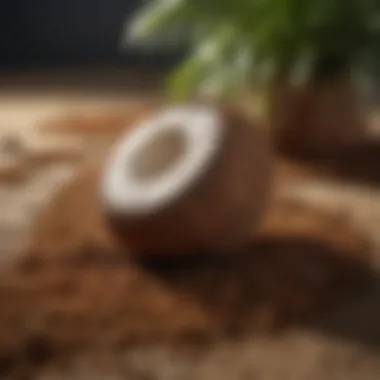
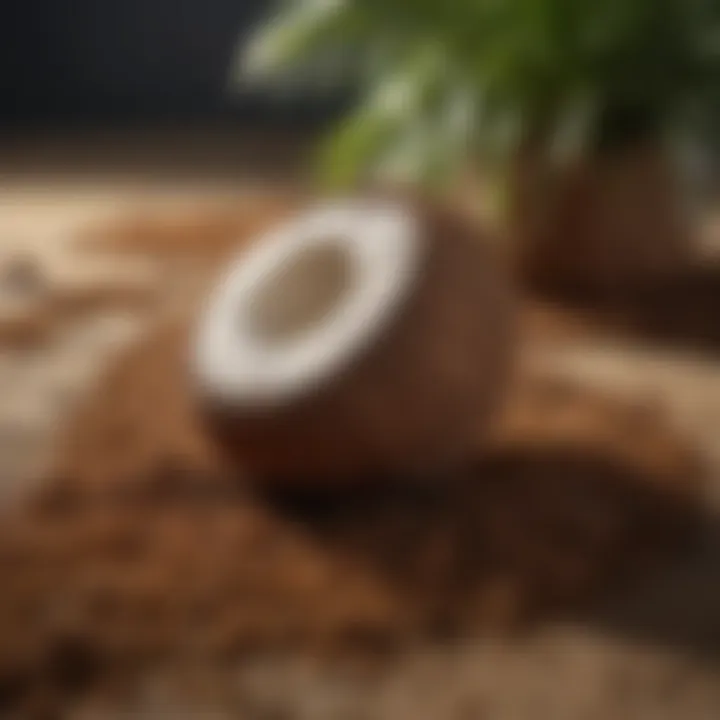
"The choice of potting mix can be the difference between a thriving garden and a lackluster one."
As we explore coconut coir's role within this context, it becomes crucial to comprehend how its unique properties contribute to creating a sustainable and effective potting mix. By making informed choices about the substrates we use, we can foster both plant health and environmental stewardship.
Understanding Coconut Coir
Coconut coir has emerged as a valuable asset in the realm of horticulture, especially as a component of potting mixes. Understanding the intricacies of coconut coir is crucial for professionals and enthusiasts alike. It not only offers a green alternative to conventional materials but also enhances plant growth and soil health.
What is Coconut Coir?
Coconut coir is a natural fiber extracted from the husk of coconuts. It serves multiple purposes, such as making ropes, mats, and brushes, but its potential in gardening is what stands out. When processed correctly, coir becomes a lightweight growing medium that retains moisture without becoming waterlogged, making it a favorite for many gardeners.
Coconut coir also has an interesting texture. It is spongy and fibrous, providing excellent aeration to the roots of plants. This balance of retention and aeration makes it suitable for a variety of planting scenarios. Its organic nature means it can enrich soil quality over time, offering benefits that can last beyond an initial planting.
Sources and Processing of Coir
The journey of coconut coir begins in tropical regions where coconuts thrive. Countries like India, Sri Lanka, and the Philippines are known for producing high-quality coir. Traditionally, the collection of coir involves soaking coconut husks to separate the fibers. This process can be labor-intensive, but it pays off in creating a product valued for its strength and versatility.
After extraction, the coir is typically processed through several stages:
- Retting: This is the initial soaking stage that allows the fibers to loosen.
- Separation: Once the fibers are separated, they are cleaned and dried.
- Grinding: To achieve the desired size, the coir can be ground, resulting in finer particles suitable for various potting mixes.
Furthermore, the processing of coir is vital when considering its quality. Quality controls and standardization have emerged in the industry, ensuring that products meet the expectations for gardeners and farmers. The right processing not only enhances the physical properties but also affects the nutrient profile of the coir.
"Coconut coir is not just an eco-friendly alternative; it's a resource that could redefine modern gardening practices."
Overall, comprehending coconut coir is fundamental to its application in horticulture. Its unique attributes contribute significantly to plant development and sustainability, making it a focal point in potting mix conversations.
Benefits of Using Coconut Coir in Potting Mix
Coconut coir is making quite the name for itself in the horticultural world, often touted as a game changer for potting mixes. Its unique composition and numerous advantages offer a sustainable and effective alternative to traditional growing mediums. When considering the continued evolution of modern horticulture, integrating coconut coir into potting mixes presents not just a trend, but a substantial path toward more eco-friendly gardening practices. Let’s take a closer look at the specific benefits that make coconut coir a standout choice.
Water Retention Properties
One of the most praised attributes of coconut coir is its incredible ability to hold moisture. This is particularly beneficial in arid climates or for those gardeners who may forget to water occasionally—let’s face it, we’ve all been there! Coir can retain up to 10 times its weight in water. This means that plants benefit from a consistent supply of moisture, which can be vital for seedlings and young plants still finding their roots.
Due to its fibrous nature, coconut coir enhances soil aeration, allowing oxygen to flow freely to plant roots while keeping the mix loose enough to prevent compaction. So it’s a double whammy: high water retention plus excellent aeration. Furthermore, this moisture retention helps reduce the frequency of watering, ultimately leading to water conservation—something we can all agree is important in today's world.
Sustainability and Environmental Impact
In an age where sustainability is the buzzword, coconut coir stands out for its eco-friendliness. Derived from the husks of coconuts that would otherwise go to waste, it presents a renewable resource that lends itself to responsible agricultural practices. By choosing coconut coir over traditional substrates like peat moss, gardeners take a step toward reducing reliance on non-renewable resources and protecting sensitive peat bog ecosystems.
Moreover, the production of coconut coir involves low-energy practices, whether it’s in production or transportation, leading to a smaller carbon footprint. This sustainable aspect positions coir as a significantly greener option for environmentally conscious gardeners. In essence, incorporating coconut coir into potting mixes dovetails seamlessly with the broader push towards ecological responsibility in agriculture.
Beneficial Effects on Plant Growth
Plants thrive on good groundwork, and coconut coir lays just that. Its unique properties often translate into better plant health and growth. Rich in potassium, dietary fiber, and other essential micro-elements, coconut coir nourishes plants by providing a hospitable environment for root development. While some might underestimate the importance of a solid foundation, experienced gardeners know: healthy roots often yield lush growth above the surface.
Another perk of coir is its pH neutrality. Unlike some traditional soil mediums, coir does not overly acidify or alkalize the soil, allowing for a well-balanced growing environment. This pH stability means that the nutrient uptake remains consistent, paving the way for robust plant development. With the right blend of coconut coir in potting mixes, gardeners may also notice increased resistance to pests and diseases, which, let’s be honest, is always a positive in maintaining vibrant plants.
"Coconut coir isn't just a soil alternative; it's a step towards sustainable gardening that benefits both your plants and the planet."
As we delve into the world of coconut coir, it becomes apparent that its multifaceted benefits make it a worthy contender in the evolution of horticultural practices. From conserving water to ensuring sustainable production and promoting plant health, incorporating coconut coir into potting mixes is indeed a smart choice for any modern gardener.
Comparing Coconut Coir with Traditional Potting Mix Components
In the ever-evolving field of horticulture, the growing awareness of sustainability and resource efficiency has made comparing ingredients in potting mixes an urgent topic. In this section, we will delve into how coconut coir stacks up against traditional potting mix components. This understanding is vital, particularly for agriculture farmers and gardening enthusiasts who want to make informed choices that will benefit their plants and the environment alike.
Coconut Coir vs. Peat Moss
When it comes to potting mixes, peat moss has long been a favorite. However, the use of coconut coir has garnered attention for its unique properties. Peat moss has excellent moisture retention, but it is often sourced from environmentally sensitive areas, leading to depletion of natural habitats. In contrast, coconut coir is derived from the husk of coconuts, making it a byproduct of coconut production. This recycling of waste is a huge plus for coir because it reduces landfill waste and decreases the need to harvest peat, which takes thousands of years to form.
Moreover, in terms of drainage and aeration, coir usually outshines peat moss. When you compare their water-holding capacities, while peat retains moisture well, coconut coir holds onto moisture without becoming waterlogged, which can be a life-saver for roots in long-term growth scenarios. The high lignin content in coir not only enhances its structure but also contributes to a more stable growing medium over time.
- Benefits of Coconut Coir over Peat Moss:
- Eco-friendly production process
- Better drainage and aeration for plant roots
- Enhanced longevity of the growing medium
"In a world increasingly inclined towards sustainability, coconut coir doesn’t just compete; it excels."
Coconut Coir vs. Soil-based Mixes
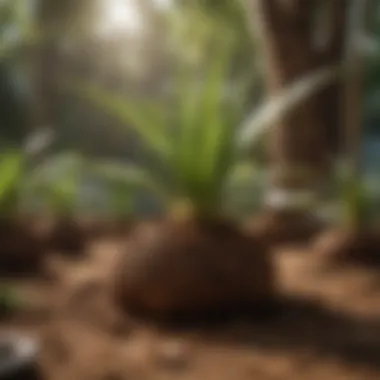
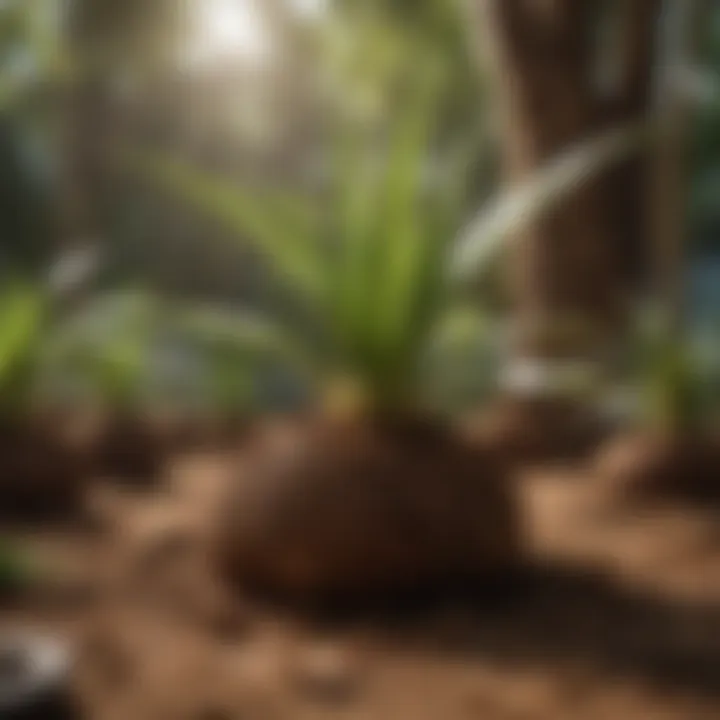
Soil-based mixes often boast robust microbial life ideal for soil health, but they can come with their own set of issues. Soil compaction is a common problem, which negatively impacts aeration and water flow. In contrast, coconut coir, known for lower compaction rates, retains its fluffy texture longer, allowing plant roots to expand freely.
Another aspect worth noting is that plant diseases can thrive in soil-based mixes, especially in setups reused year after year. This poses a risk for gardeners who may be unknowingly cultivating pathogens that could wipe out their plants. Coir, on the other hand, tends to have a lower initial pathogen load, offering a fresh start for every planting cycle.
- Advantages of Coconut Coir Over Soil-based Mixes:
- Less prone to compaction, enhancing root development
- Lower risk of soil-borne diseases
- Can be reused effectively with appropriate management
As we continue to explore the advantages that coconut coir brings to modern horticulture, it becomes clear that the comparison isn't just about what is better but also why these choices matter. Understanding these nuances can empower farmers and enthusiasts alike to maximize their gardening endeavors.
How to Select the Right Coconut Coir Product
Choosing the right coconut coir product is crucial for anyone venturing into horticulture. The multifaceted nature of coconut coir allows for diverse applications, but not all products are created equal. Picking up the wrong type can cause more headaches than a gardener bargained for. Therefore, it's essential for both new and seasoned gardeners to know what to look for when selecting coconut coir. This section aims to bridge that gap.
Types of Coconut Coir Products
Coconut coir comes in several forms, each suited for specific horticultural needs. Understanding these types is the first step to making an informed choice:
- Coir Fiber: This is the raw form of coconut coir, consisting of long fibers extracted from the coconut husk. It’s typically used for drainage and aeration in potting mixes.
- Coir Pith (or Coir Dust): This is a spongy by-product of coir fiber that provides excellent water retention. It's particularly useful for potting mixes needing high moisture levels.
- Compressed Coir Bricks: As the name suggests, these are compacted bricks that expand when hydrated. They are beneficial for transportation and easy storage.
- Coir Mats: Generally used for erosion control and landscaping, these mats can also act as weed blockers and moisture retainers when integrated into soil.
- Blended Coir Products: Some products combine coir with nutrients or other growing mediums to enhance performance. These blends target specific gardening situations, making them versatile options.
Each type of coir product serves its purpose, and understanding the differences can help make more tailored horticultural decisions.
Choosing Quality and Performance
When it comes to quality, not all coconut coir products measure up. Subpar coir can come laden with salts or harmful residues that could hinder plant growth. Here are key points to consider:
- Check for Salt Content: High salt levels in coir can harm plants. Always look for products that have been rinsed or processed to reduce salt. Testing the product before use is prudent, especially if you are dealing with sensitive crops.
- pH Balance: Good quality coir should have a neutral pH, ideally around 6.0 to 6.8. This range is generally optimal for most plants. It’s worth checking product specifications or testing the pH yourself.
- Fiber Quality: Look for long, sturdy fibers in coir products as they can improve aeration while providing structural integrity in potting mixes. A chunkier texture is usually a sign of superior quality.
- Sustainability Certifications: As an environmentally conscious gardener, seek products that are sustainably sourced. Certifications can provide insight into a brand's practices, signaling responsible harvesting and manufacturing processes.
- Performance Reviews: Don’t shy away from doing your homework. Online reviews, gardening forums on websites like reddit.com, and feedback on agricultural products can steer you toward reputable brands.
Preparing Coconut Coir for Planting
Preparing coconut coir for planting is not just a simple task, it’s a crucial step that can significantly impact your plants’ growth and overall health. For gardeners and agricultural enthusiasts, understanding how to properly prepare coir ensures that you get the most out of this sustainable resource. It’s kind of like cooking—if you don’t prepare your ingredients right, the final dish will hardly taste good. In this case, coir acts as a central ingredient in your potting mix, serving as the framework for your plants' root systems.
Hydration Techniques and Timing
Hydrating coconut coir is one aspect where many gardeners might trip up if they’re not careful. Coir starts off as a dry, dense material, which can be quite unyielding when it comes to absorbing water. When you’re ready to hydrate it, timing and technique are key. Generally, soaking coir in water for about 30 minutes to an hour is recommended. This allows the fibers to expand, making them more pliable and easier to work with. Make sure the water is clean; you don’t want your plants to be drinking anything nasty.
It’s also vital to think about the quality of the water. Some folks have hard water rich in minerals that can build up over time, causing pH issues and affecting plant health. If you’re serious about your gardening, consider using distilled or rainwater for the best results. Once hydrated, give it a good squeeze. If water drips out, it’s likely ready to mix with other components.
"Getting your coir well-hydrated could be the difference between thriving plants and those that just limp along."
Mixing with Other Components
Once your coconut coir is prepped, the next step is to mix it with other components to create a well-balanced potting mix. This isn’t a one-size-fits-all scenario; the right mix often depends on what you’re growing. For example, combining coir with perlite enhances drainage, which is beneficial for plants like succulents that hate sitting in soggy soil. On the flip side, if you're potting something that likes to retain moisture, like a tropical plant, blending coir with vermiculite is a smart move.
When mixing, it’s good practice to keep the ratios balanced. A typical mixture can be around 70% coir to 30% perlite or another additional medium. Adjust as necessary based on the needs of your plants. Also, keep in mind the nutrient profile of your mix. Coir is relatively low in nutrients, so integrating organic fertilizers or compost can provide the extra kick your plants need.
Ultimately, the preparation of coconut coir is about creating an environment that supports your plants. Paying attention to hydration techniques and the right mixing components helps lay down a solid foundation for a lush garden. Whether you’re going for houseplants in a cozy apartment or rows of veggies in a backyard, starting off on the right foot with your coir mix can lead you to greener pastures.
Applications of Coconut Coir in Gardening and Agriculture
Coconut coir emerges as a jackpot solution for various horticultural needs. Its unique properties extend across a plethora of applications within gardening and agriculture, making it a popular choice among growers seeking sustainable options. By leveraging the versatility of coir, enthusiasts can address specific challenges faced in both indoor and outdoor environments, while contributing positively to ecological sustainability.
The importance of understanding these applications lies in the need for effective and environmentally-friendly growing mediums. Every garden or agricultural venture has its own set of demands, and coconut coir aligns closely with an eco-conscious approach, allowing for improved plant health and growth. With its lightweight structure and excellent water retention, coir supports a myriad of gardening techniques and practices.
Indoor Gardening with Coir
When it comes to indoor gardening, coconut coir provides an ideal medium for cultivating vibrant houseplants. It’s like a bed of clouds for root systems; airy, yet dependable. The exceptional moisture retention capability of coir ensures that plants receive consistent hydration over time, making it especially beneficial for novice gardeners who might sometimes miss the watering schedule. It allows air to circulate freely around the roots, minimizing the risk of root rot.
Beyond the moisture aspect, coir is also free from soil-borne diseases. Using coir as a growing medium can lead to less hassle when it comes to plant maintenance. You don't have to worry much about pathogens as you would with traditional soil.
- Benefits of Indoor Gardening with Coir:
- Consistent moisture availability
- Prevention of root diseases
- Enhanced air circulation around roots
In summary, using coconut coir indoors not only supports lush plant growth but also makes it easier to maintain a healthy indoor ecosystem.
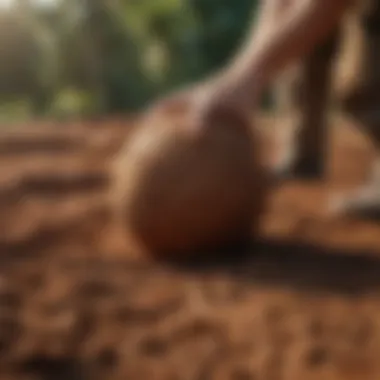
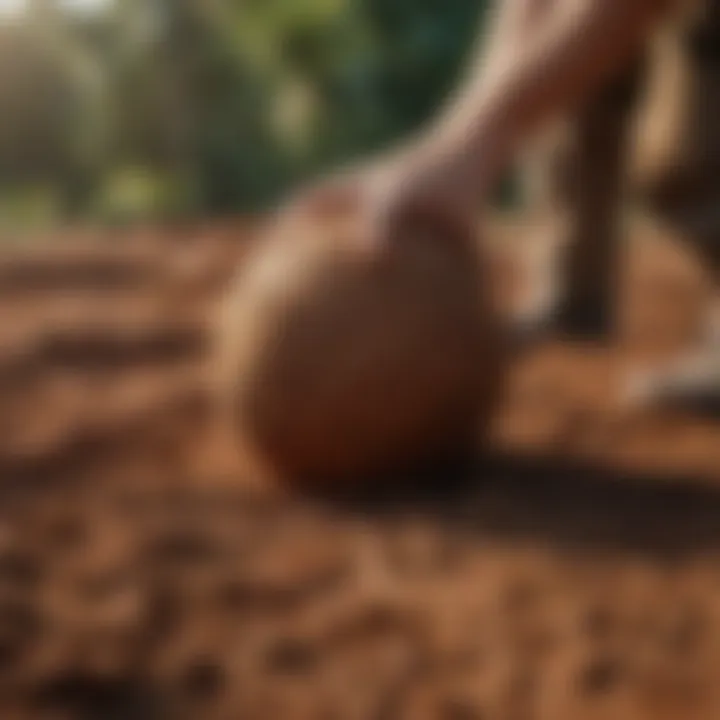
Outdoor Use and Container Gardening
For those who like to take their green thumbs outside, coconut coir excels in outdoor settings as well. Its lightweight nature makes it a favored medium for container gardening, where weight considerations are crucial. Whether one’s tending to a small patio garden or larger plot, coir provides a robust mix that encourages drainage while holding onto essential moisture.
When using coir, outdoor gardeners find that it tends to resist compacting, a trait especially valuable in areas with heavy rains. This ensures that excess water drains away instead of pooling around plant roots, thus reducing the likelihood of waterlogging and rot.
- Notable Points for Outdoor Use:
- Excellent drainage properties
- Lightweight and easy to handle
- Minimal risk of waterlogging
For container gardening, mixing coconut coir with perlite or vermiculite can produce a superior potting mix that keeps plants well-fed and thriving, even in urban environments.
Hydroponics and Coir Substrates
Now, for the hydroponic enthusiasts, the play with coconut coir is absolutely game-changing. Coir serves as an excellent substrate, providing a solid foundation for plants to grow without soil while still tapping into that moisture retention and aeration balance. In hydroponics, the coir substrate works harmoniously alongside nutrient solutions to nourish plants effectively.
Getting a good grip on coir’s adaptability can lead to high yields in hydroponic systems. Its ability to retain water while offering a conducive pH environment makes for an ideal growing medium. Just like one might tune an instrument, the right mixture of coir with other components can lead to a harmonized system, yielding healthy plants that reach their full potential.
- Key Benefits in Hydroponics:
- Maintains moisture while allowing proper drainage
- Adjustable pH levels conducive for plant growth
- High yield potential when paired correctly with nutrients
Ultimately, the application of coconut coir in hydroponics provides a way to grow plants sustainably, opening doors to urban gardening as well as commercial applications without over-reliance on traditional soil solutions.
Thus, by tapping into the potential of coconut coir, gardeners and farmers alike can maximize their efforts toward creating healthier plants and richer growing experiences.
Potential Challenges and Considerations
When discussing the use of coconut coir in potting mixes, it’s essential to shine a light on some of the potential challenges and considerations that come along with it. While coconut coir boasts numerous benefits, understanding these hurdles ensures that gardeners and horticulturists can make informed decisions for their plants. While many focus purely on the advantages, the reality is that effective gardening requires a comprehensive grasp of the entire growing medium landscape—including its possible pitfalls.
Addressing Salt Content
One of the most significant concerns with coconut coir is its inherent salt content. Coconut coir is derived from the husks of coconuts and, through the process of harvesting and processing, it can accumulate salts. Elevated salt levels can lead to osmotic pressure, which can stress plants by making it difficult for them to absorb water.
To tackle this issue, it’s important for users to take a few proactive steps:
- Rinse the Coir: Before mixing coir into a potting soil or using it straight, rinsing with freshwater can significantly reduce salt levels. This process may require multiple rinses to ensure that adequate salt leaching has been achieved.
- Choose Quality Suppliers: Opting for coir products from reputable suppliers can enhance the chances of acquiring lower-salt options, as many companies implement additional processing to remove excess salts.
- Soil Tests: Regular soil testing can help monitor salinity levels. This allows for preemptive actions before any negative impacts are felt by the plants.
"Detecting high salt levels early on can save a gardener a lot of grief down the road."
Managing pH Levels
Managing pH levels in coconut coir mixes is another crucial consideration. The ideal pH for most plants typically hovers around 5.5 to 7.0. However, coconut coir can have a slightly alkaline pH, usually ranging from 6.0 to 7.5. This can pose challenges, particularly for plants that thrive in more acidic conditions.
Here are some ways to manage pH levels effectively:
- Testing the Mix: Regular pH testing using reliable testers can provide insights into the acidity or alkalinity of your mix. It ensures you know precisely where you stand before planting.
- Amending the Soil: Adding amendments like elemental sulfur can help lower pH, whereas lime is used to raise it. This approach allows for fine-tuning depending on the specific needs of the plants being grown.
- Watering Practices: Sometimes the water used can also affect pH levels. Rainwater typically has a lower pH, while tap water can vary depending on local conditions. Knowing your water source can therefore be beneficial in maintaining the desired pH for plant health.
Both salt content and pH management are pivotal for achieving optimal plant health and growth. By recognizing and addressing these factors effectively, gardeners can not only mitigate potential risks but also maximize the advantages that coconut coir offers as a growing medium.
Culmination
The discussion around potting mixes involving coconut coir serves not only practical purposes in gardening but also emphasizes our collective responsibility towards sustainable horticultural practices. By leveraging the unique benefits of coconut coir, we not only enrich the growing medium but also support environmental sustainability. This fosters an ecosystem where both the plants and the growers can thrive without excessive reliance on traditional, often detrimental, materials.
Recap of Benefits
To summarize, there are several noteworthy advantages of integrating coconut coir into potting mixes:
- Water Retention: Coconut coir excels in retaining moisture, which can significantly reduce watering frequency.
- Aeration: The fibers in coir allow for air flow to plant roots, promoting healthier growth and stronger root systems.
- pH Neutrality: Unlike some organic materials, coconut coir is naturally pH neutral, thus being safe for a wide range of plants.
- Lightweight: This makes handling, transporting, and working with coir much easier than heavier alternatives.
- Sustainability: Using coir contributes to reducing the carbon footprint of gardening, minimizing the use of mined peat moss.
These benefits create a robust case for using coconut coir, appealing not just to seasoned horticulturists but also to novice gardeners aiming for sustainable practices.
Future of Coconut Coir in Horticulture
Looking ahead, the future of coconut coir in horticulture appears bright. As awareness increases about sustainable practices, the demand for natural and biodegradable products is slated to rise. Innovations in processing techniques may enhance the appeal of coir, making it more accessible and versatile in various gardening applications. It’s conceivable that we may witness the development of specialized blends that optimize the properties of coconut coir for particular types of plants or growing environments.
Additionally, academic research into the effects of coconut coir on plant growth and soil health is expected to yield valuable insights. This could substantiate coir's role in combating issues like soil degradation and artisan agriculture, leading to more widespread adoption in the industry.
The shift towards using coconut coir in gardening aligns with the global momentum towards eco-friendly practices, paving the way for a greener, more sustainable future in horticulture.
As we continue to evolve our understanding of plant growth and environmental stewardship, coconut coir will not just be a fallback option but a cornerstone of modern horticulture.



